The Strathcona Regional District is weighing a new policy on how residents can request services.
This could cover anything from streetlights in a localized area to large-scale service.
Past practices have leaned toward residents, at least those living in the unincorporated electoral areas, contacting their local area director about bringing forward a request to the board.
The proposed policy though could give people more options, meaning they could bring a request to the board directly. The draft policy was prepared following a motion from Andy Adams, Campbell River’s mayor and one of its SRD directors, at a meeting last November.
For some on the board, the current practice is working just fine. Area A Director Gerald Whalley said the policy fails to distinguish between regional services and services solely within an electoral area.
“This ought not to have anything to do with electoral area services, and that wasn’t the intent,” he said.
Whalley also disputed the idea that members of the public would now be able to come forward with requests to the board rather than go through the electoral area director.
“I think that should be done through elected officials. That’s our mandate, that’s what they voted us into office for,” he said.
Area B Director Noba Anderson said the policy was a result of requests for service on Cortes and that the intent was that it cover all SRD services, whether regional, sub-regional or area specific. She suggested the item be deferred until the mover Adams and chief administrative officer Dave Leitch, who were not at the last meeting, could clarify the intent.
Area C Director Jim Abram echoed Whalley’s concerns and did not support deferring the matter but rather sending the policy to staff to answer some questions, or possibly the board’s Electoral Area Services Committee (EASC).
“Service proposals in rural areas usually come from the electoral area director,” he said. “Services are not initiated by community groups…. The process we have in place now works just fine…. If it’s not broken, why would we want to fix it?”
A referendum, Whalley said, can cost up to $20,000, which is significant for small communities, meaning it is even more important for area directors to have a sense of community interest in a proposed service.
When informed the board would still seek input from an electoral area director, Whalley added the policy seems like a “long, roundabout” way of ending back at the local director, adding the matter should be sent there first rather than wasting board time.
A referendum, Whalley said, can cost up to $20,000, which is significant for small communities, meaning it is even more important for area directors to have a sense of community interest in a proposed service.
When informed the board would still seek input from an electoral area director, Whalley added the policy seems like a “long, roundabout” way of ending back at the local director, adding the matter should be sent there first rather than wasting board time.
Charlie Cornfield, one of the Campbell River directors, said the policy’s intent is not to circumvent electoral area directors and does not preclude anyone from talking to their area director.
“This just lays it out, so it can be handed out to anybody that’s interested in establishing a service,”’ he said.
Some board members wanted the matter to go to EASC first. However, the board voted to defer to this week’s meeting, with directors Whalley, Abram, Area D Director Brenda Leigh and Ron Kerr of Campbell River opposing. (This story went to press before the meeting.)
